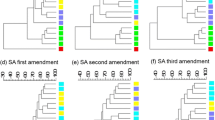Summary
Data on the use of a biological containment system in microcosms are presented. The system is based on a transposon Tn5-cassette containing a fusion of the lac promoter and gef controlled by lacIQ. The suicide function was inserted into different bacterial hosts and its induction by isopropyl-β-d-thiogalactoside (IPTG) was tested in sterile and non-sterile soil microcosms. The results suggest that the killing effect of this gef-based suicide mechanism is insufficient under soil conditions.
Similar content being viewed by others
References
Armstrong JL, Knudsen GR, Seidler RJ (1987) Microcosm method to assess survival of recombinant bacteria associated with plants and herbivorous insects. Curr Microbiol 15:229–232
Armstrong JL, Porteous LA, Wood ND (1989) The cutworm Peridroma saucia (Lepidoptera: Noctuidae) supports growth and transport of pBR 322-bearing bacteria. Appl Environ Microbiol 55:2200–2205
Armstrong JL, Wood ND, Porteous LA (1990) Transconjugation between bacteria in the digestive tract of the cutworm Peridroma saucia. Appl Environ Microbiol 56:1492–1493
Anderson T-H, Domsch KH (1986) Carbon assimilation and microbial activity in soil. Z Pflanzenernaehr Bodenkd 149:457–468
Bej AK, Perlin MH, Atlas RM (1988) Model suicide vector for containment of genetically engineered microorganisms. Appl Environ Microbiol 54:2472–2477
Casadaban M, Cohen SN (1980) Analysis of gene control signals by DNA fusion and cloning Escherichia coli. J Mol Biol 138:179–207
Compeau G, Al-Achi BJ, Platsouka E, Levy SB (1988) Survival of rifampicin-resistant mutants of Pseudomonas fluorescens and Pseudomonas putida in soil systems. Appl Environ Microbiol 54:2432–2438
Cuskey SM (1988) Survival, persistence and colonization: Round table 3. In: Sussman M, Collins CH, Skinner FA, Stewart-Tull DE (eds) The release of genetically-engineered micro-organisms. Academic Press, London San Diego New York Berkeley Boston Sydney Tokyo Toronto, pp 231–237
Domsch KH, Driesel AJ, Goebel W, Kraus P, Lindenmaier W, Lotz W, Reber H, Schmidt F (1988) Considerations on release of gene-technologically engineered microorganisms into the environment. FEMS Microb Ecol 53:261–272
Farabaugh PJ (1978) Sequence of the lacI gene. Nature 274:763–769
Henschke RB, Schmidt FRJ (1989) Survival, distribution and gene transfer of bacteria in a compact soil microcosm system. Biol Fertil Soils 8:19–21
Henschke RB, Schmidt FRJ (1990a) Plasmid mobilization from a genetically engineered microorganism to members of the indigenous soil microflora in situ. Curr Microbiol 20:105–110
Henschke RB, Schmidt FRJ (1990b) Screening of soil bacteria for plasmids carrying antibiotic resistance. Biol Fertil Soils 9:257–260
Henschke RB, Nücken E, Schmidt FRJ (1989) Fate and dispersal of recombinant bacteria in a soil microcosm containing the earthworm Lumbricus terrestris. Biol Fertil Soils 7:374–376
Lynch JM (1990) Longevity of bacteria: Considerations in environmental release. Curr Microbiol 20:387–389
Miller RV (1988) Potential for transfer and establishment of engineered genetic sequences. Trends Ecol Evol 3:23–27
Molin S, Klemm P, Poulsen LK, Gerdes K, Andersson P (1987) Conditional suicide system for containment of bacteria and plasmids. Bio/Technol 5:1315–1318
Molin S, Klemm P, Poulsen LK (1988) Biological containment of bacteria and plasmids to be released in the environment. In: Klingmüller W (ed) Risk assessment for the deliberate releases. Springer Verlag, Berlin Heidelberg New York London Paris Tokyo, 127–135
Morel JL, Bitton G, Chaudhry GR, Awong J (1989) Fate of genetically modified microorganisms in the corn rhizosphere. Curr Microbiol 18:355–360
Poulsen LK, Larsen NW, Molin S, Ansersson P (1989) A family of genes encoding a cell-killing function may be conserved in all Gram-negative bacteria. Mol Microbiol 3:1463–1472
Simon R, Priefer U, Pühler A (1983) A broad host range mobilization system for in vivo genetic engineering transposon mutagenesis in Gram-negative bacteria. BioTechnol 784–795
van Elsas JD, Govaert JM, van Veen JA (1987) Transfer of plasmid pFT 30 between bacilli in soil as influenced by bacterial population dynamics and soil conditions. Soil Biol Biochem 19:639–647
Wessendorf J, Lingens F (1989) Effect of culture and soil conditions on survival of Pseudomonas fluorescens R1 in soil. Appl Microbiol Biotechnol 31:97–102
Author information
Authors and Affiliations
Rights and permissions
About this article
Cite this article
Henschke, R.B., Henschke, E.J. & Schmidt, F.R.J. Use of the gef gene in a biological containment system in soil microcosms. Biol Fertil Soils 11, 301–305 (1991). https://doi.org/10.1007/BF00335852
Received:
Issue Date:
DOI: https://doi.org/10.1007/BF00335852




